Clinical significance of dihydropyrimidine dehydrogenase in adjuvant 5-fluorouracil liver perfusion chemotherapy for pancreatic cancer
- PMID: 15492566
- PMCID: PMC1356490
- DOI: 10.1097/01.sla.0000143300.49878.51
Clinical significance of dihydropyrimidine dehydrogenase in adjuvant 5-fluorouracil liver perfusion chemotherapy for pancreatic cancer
Abstract
Objective: To clarify the relationship between intratumoral dihydropyrimidine dehydrogenase (DPD) expression and response to 5-fluorouracil (5-FU) liver perfusion chemotherapy (LPC) in pancreatic cancer patients, we evaluated DPD expression immunohistochemically in resected pancreatic cancer tissues.
Summary background data: Pancreatic cancer is considered a disease with a poor prognosis even if aggressive resection is performed. One of the main causes of death is hepatic metastasis soon after surgery. As a treatment, we have assessed adjuvant LPC via the portal vein using 5-FU just after pancreatectomy for advanced pancreatic cancer since 1994. However, the results remain unsatisfying.
Methods: Sixty-eight resected specimens were obtained from patients with pancreatic cancer from 1988 to 2000. Formalin-fixed paraffin-embedded tissues were immunostained with polyclonal anti-DPD antibody. The relation between intratumoral DPD expression and the prognoses of pancreatic cancer patients was investigated statistically.
Results: Of the 68 tumors studied, 27 carcinomas (39.7%) were DPD(+), and 41 (60.3%) were DPD(-). In the DPD(+) group, there was no significant difference between the LPC(+) and LPC(-) subgroups, whereas in the DPD(-) group the LPC(+) subgroup showed a significantly higher survival rate than the LPC(-) subgroup. Moreover, in the LPC(+) group, overall survival in the DPD(-) subgroup was significantly better than in the DPD(+) subgroup.
Conclusions: An immunohistochemical evaluation of intratumoral DPD expression might be useful in predicting responsiveness to 5-FU-based chemotherapy in pancreatic cancer patients. In the DPD(-) group, liver perfusion chemotherapy using 5-FU via the portal vein is effective adjuvant therapy for pancreatic cancer once pancreatectomy has been performed.
Figures



Similar articles
-
Prognostication of pancreatic adenocarcinoma by expression of thymidine phosphorylase/dihydropyrimidine dehydrogenase ratio and its correlation with survival.Expert Opin Drug Saf. 2009 Sep;8(5):507-14. doi: 10.1517/14740330903173217. Expert Opin Drug Saf. 2009. PMID: 19663627
-
Predictive role of thymidylate synthase, dihydropyrimidine dehydrogenase and thymidine phosphorylase expression in colorectal cancer patients receiving adjuvant 5-fluorouracil.Oncology. 2006;70(5):366-77. doi: 10.1159/000098110. Epub 2006 Dec 15. Oncology. 2006. PMID: 17179731
-
Liver perfusion chemotherapy for selected patients at a high-risk of liver metastasis after resection of duodenal and ampullary cancers.Ann Surg. 2007 Nov;246(5):799-805. doi: 10.1097/SLA.0b013e318158fc7f. Ann Surg. 2007. PMID: 17968172
-
[Expression of dihydropyrimidine dehydrogenase in primary colorectal cancer and liver metastasis--a relationship between mRNA levels in cancer cells and protein levels in cancerous tissue and effect of 5-fluorouracil].Gan To Kagaku Ryoho. 2009 Nov;36(12):2232-5. Gan To Kagaku Ryoho. 2009. PMID: 20037380 Review. Japanese.
-
The Impact of the Expression Level of Intratumoral Dihydropyrimidine Dehydrogenase on Chemotherapy Sensitivity and Survival of Patients in Gastric Cancer: A Meta-Analysis.Dis Markers. 2017;2017:9202676. doi: 10.1155/2017/9202676. Epub 2017 Jan 31. Dis Markers. 2017. PMID: 28255193 Free PMC article. Review.
Cited by
-
Systemic therapies for pancreatic cancer--the role of pharmacogenetics.Curr Drug Targets. 2012 Jun;13(6):811-28. doi: 10.2174/138945012800564068. Curr Drug Targets. 2012. PMID: 22458528 Free PMC article. Review.
-
Portal vein infusion chemotherapy with gemcitabine after surgery for pancreatic cancer.Surg Today. 2013 Jan;43(1):33-9. doi: 10.1007/s00595-012-0179-8. Epub 2012 Apr 11. Surg Today. 2013. PMID: 22492275
-
Genomic profiling guides the choice of molecular targeted therapy of pancreatic cancer.Cancer Lett. 2015 Jul 10;363(1):1-6. doi: 10.1016/j.canlet.2015.04.009. Epub 2015 Apr 15. Cancer Lett. 2015. PMID: 25890222 Free PMC article. Review.
-
FOLFIRINOX and translational studies: Towards personalized therapy in pancreatic cancer.World J Gastroenterol. 2016 Aug 21;22(31):6987-7005. doi: 10.3748/wjg.v22.i31.6987. World J Gastroenterol. 2016. PMID: 27610011 Free PMC article. Review.
-
Oncological problems in pancreatic cancer surgery.World J Gastroenterol. 2006 Jul 28;12(28):4466-72. doi: 10.3748/wjg.v12.i28.4466. World J Gastroenterol. 2006. PMID: 16874856 Free PMC article. Review.
References
-
- Nakao A, Nonami T, Harada A, et al. Portal vein resection with a new antithrombogenic catheter. Surgery. 1990;108:913–918. - PubMed
-
- Nakao A, Takagi H. Isolated pancreatectomy for pancreatic head carcinoma using catheter bypass of the portal vein. Hepatogastroenterology. 1993;40:426–429. - PubMed
-
- Griffin JF, Smalley SR, Jewell W, et al. Patterns of failure after curative resection of pancreatic carcinoma. Cancer. 1990;66:56–61. - PubMed
-
- Kayahara M, Naganawa T, Ueno K, et al. An evaluation of radical resection for pancreatic cancer based on the recurrence as determined by autopsy and diagnostic imaging. Cancer. 1993;72:2118–2123. - PubMed
-
- Sperti C, Pasquali C, Piccoli A, et al. Recurrence after resection for ductal adenocarcinoma of the pancreas. World J Surg. 1997;21:195–200. - PubMed
MeSH terms
Substances
LinkOut - more resources
Full Text Sources
Medical
Research Materials

